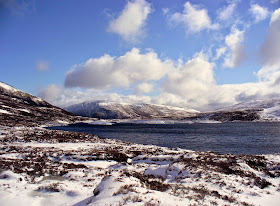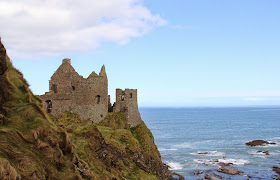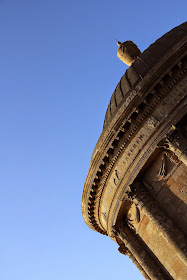I've heard many people complaining that Spring in Scotland this year keeps providing us with "all four seasons in one day". That may be the case down in the cities, but high on the remote mountains of the Cairngorms National Park today I encountered only one: Winter. Thankfully I had checked the Mountain Weather Information Service last night, and so packed all my winter walking gear, thermals, hats, gloves, full Winter waterproofs, and extra layers. The MWIS often errs on the side of caution in its estimation of weather severity, but they were spot on with their warnings of high winds, hail, sleet and sub-zero temperatures. All of these assaulted me in succession all day long, making the completion of what should have been a simple round into a significant challenge.
These hills are often approached from Deeside to the North by means of Glen Ey, but I decided to reach them from The Spittal of Glenshee to their South East. Parking up by the old stone bridge at the Spittal, I was shocked by the sight of the charred ruins of the Hotel/restaurant complex which once dominated the hamlet. Externally it was never a beautiful building, while inside it was designed to cater for the coach-tour market with garish tartan carpets and shortbread for sale by the metric tonne. Despite this, it was always a place to stop en route to Braemar and fill up with coffee. The mangled and blackened remains of what was once a little hive of activity was a forlorn sight indeed.
The Shee Water is a substantial river which flows South-Easterly out from these hills, feeding into the great River Ericht further downstream. At The Spittal it has tracks running up both its banks. The West bank has a road which leads up to the Dalmunzie House Hotel, which is an impressive Victorian pile tucked away in the hills. I began my day cycling along the track on the other bank, which climbs steadily up Glen Shee, and then turns Northwards into Gleann Taitneach.
Looking back towards The Spittal of Glenshee
The high winds funnelled down the glen into my face, making progress very difficult and very slow indeed. I dumped my bike just before the end of the bulldozed track, and followed the scratchy path up the river past a series of waterfalls. The battle against the wind didn't detract from the beauty of the great glacial formations through which I was travelling. The flat, plateau-like summits were decorated with ice, which were a reminder of the great ice movements which scoured out this flat-bottomed glen tens of thousands of years ago. Rather disturbingly, I found myself singing, Flat-bottomed-glens you make the rockin' world go round!, perhaps imagining what might have transpired had Freddie studied Geography instead of art...
The Allt Easgaidh is the outflow of the Loch nan Eun, a magnificent little loch tucked high in the mountains at the head of a lonely glen. It is so lonely up there that I didn't set eyes on a soul all day - the only evidence of other humans were three mountain bikes locked together by the side of the track. One of the many curious complexities of my personality is that when surrounded by noise, people, busyness and housework I find myself longing to be alone in the hills, experiencing real isolation and alone-ness; yet when I get there I so often wish that it was possible to share this experience with someone.
From the western corner of the loch, in driving snow and poor visibility (the above photo was taken on my way back down!) I struck South-Westerly in seach of the stalkers path that would skirt the obstacle of Mam nan Cairn, and lead me to the slopes of Carn an Righ. Despite the snow, the path soon appeared to my right, and I crossed the boggy, snowy and tussocky ground to gain it and half an hour later it brought me to the foot of the hill. The OS Map has the path turning Northwards past spotheight 771 on the 1:25000 map. However, in practice it bifurcates, the right hand fork being as shown on the map, and an unrecorded path heading for the mountain. It's a tough slog from the col at 771m to the summit, marked as 1029 (although bizarrely my GPS thought it was higher than that!), which was make infinitely worse by the deteriorating weather. The snow underfoot made going hard, but the biggest issue was the icy, driving wind which was relentless and hard to manage. Thankfully at the summit cairn a small dry-stone wall has been constructed which provided some shelter, but even here it was a struggle to put on my extra layer, and read the map.
I had decided to abandon the walk at this point and simply retrace my steps. I knew that once in the shelter of the valley-floor I'd get some respite from the Arctic-blast, and thought that the tops were becoming unsafe. Happily however as I made the col, the weather changed, the wind and snow dropped, and the route across the Mam nan Cairn to Beinn Iutharn Mhor appeared. It looked too tempting to miss, and so I began the climb. I took too low a traverse around Mam nan Cairn and ended up pulling myself up a very steep climb to the ridge through snow deep enough to make my knees and leg muscles burn. Once on the ridge, the pull up to the summit of Beinn Iutharn Mhor was hard, but satisfying. The views were magnificent however!
Carn an Righ from Beinn Iutharn Mhor
Descending around through the gap between Beinn Iutharn Beag and Mam nan Cairn, it was a wet and slippery descent to the loch, around to its outflow, and back alongside the river to my waiting bike, and the long pedal home.
Descending to the Loch nan Eun
Looking through my photos I realise that they are rather unrepresentative of the day. They were all taken in the few minutes when the sun shone. For most of the time, the little camera was zipped tightly into my rucksack, because of the conditions - and this is the last day of April! Putting the route on the computer tonight, I was astonished to find that it was only 20 Miles - I feel as if I have done twice that!










































.jpg)

.jpg)
.jpg)


.jpg)
.jpg)
